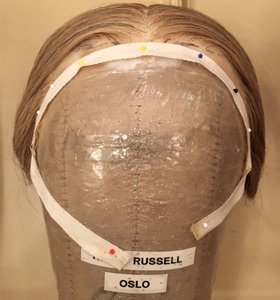In Oslo, Henny Russell portrays three characters, two Norwegian, one Swedish: the foreign-policy expert Marianne Heiberg, the hospitable cook Toril Grandal, and a haughty hostess. How does Russell, who grew up near Chicago, differentiate between her assignments?
“In rehearsal,” she told me in her dressing room before an evening performance, “you find the essential internal differences between your characters. When you put on the clothing and the wigs, you discover the more physical manifestations.”
“Marianne,” Russell said, “was a very intelligent woman. She had a doctorate, was an expert in Middle Eastern policy, and did things at the U.N.” This character’s hair and heels, Russell added, “are professional yet attractive.”
The hostess also wears heels, but more imperiously than does the Norwegian policy expert. “Backstage, we call the hostess Miss Sweden,” said Russell. One of the keys to her very erect posture lies in her hair. “The wig itself has been very processed,” Russell explained, lauding the way that costume designer Catherine Zuber and Hair and Wig Designer Tom Watson devised all the looks. “John McNulty, our very talented Hair and Wig Supervisor,” Russell went on, “gets the hostess’s wig perfectly coiffed. But I have to keep my chin up, or the wig will come forward. And if I turn too quickly, the wig will stick to my lipstick. So part of the stiffness of the Swedish hostess is me keeping the wig in place.”
The aspects of Toril, both internal and external, are more personal: Russell’s mother was Norwegian. “She came to this country when she was 20,” Russell said. “She was number seven of eight of children. Four settled in the States and the other four stayed in Norway.”
When Russell’s mother died, in August of 2015, Russell and one of her two sisters put together a book of their mother’s photos and recipes, which Russell keeps in her dressing room. “When we were doing the play in the Mitzi, last year,” she said, referencing LCT’s off-Broadway space and the Oslo director, Bartlett Sher, “I showed the book to Bart. We already had the waffles, but Bart felt there needed to be some dialogue, to ease the transition between the Israelis and Palestinians fighting and their sitting down to something sweet. So J.T.” – J.T. Rogers, the Oslo playwright – “looked at my mom’s recipe. The next day I got a new page of dialogue. My eyes filled with tears because the first line was, ‘This is the waffle recipe of my mother.’”
For Russell and members of her family who’ve seen the play, that waffle scene is touching; for some Norwegians, by contrast, it is touchy. “Originally, and even in the published script of the play, we served the waffles with lingonberries,” Russell said. “But in Norway, they are served with meat, never with waffles. Several Norwegians who saw Oslo gently chastised J.T. They said, ‘We love the play but you can’t serve lingonberries with waffles.’ So now we use raspberries.”
Swedes use may use berries similarly, but don’t assume Scandinavians are the same otherwise. “My mother was very insulted if someone thought she was Swedish,” Russell said. “She would have appreciated the joke that Thor” – a security professional – “makes in the play. He says there are no differences between Israelis and Palestinians. But ‘if you want to talk about Norwegians and Swedes, then we are talking about differences.’”
Brendan Lemon is the editor of lemonwade.com



